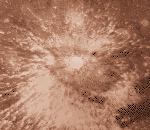
|
|
Ganymede ("GAN uh meed") is the seventh and largest of Jupiter's known satellites. Ganymede is the third of the Galilean moons.
orbit: 1,070,000 km from Jupiter
diameter: 5262 km
mass: 1.48e23 kg
Ganymede was a Trojan boy of great beauty whom Zeus carried away to be cupbearer to the gods.
Discovered by Galileo and Marius in 1610.
Ganymede is the largest satellite in the solar system. It is larger in diameter than Mercury but only about half its mass. Ganymede is much larger than Pluto.
Before the Galileo encounters with Ganymede it was thought that Ganymede and Callisto were composed of a rocky core surrounded by a large mantle of water or water ice with an ice surface (and that Titan and Triton were similar). In fact, Ganymede may be similar to Io with an additional outer layer of ice.

 Ganymede's
surface is a roughly equal mix of two types of terrain: very
old,
highly cratered dark regions (left), and somewhat younger (but still
ancient) lighter regions marked with an extensive array of grooves
and ridges (right). Their origin is clearly of a tectonic nature,
but the details are unknown. In this respect, Ganymede may more
similar to the Earth
than either Venus
or Mars
(though there is no evidence of recent tectonic activity).
Ganymede's
surface is a roughly equal mix of two types of terrain: very
old,
highly cratered dark regions (left), and somewhat younger (but still
ancient) lighter regions marked with an extensive array of grooves
and ridges (right). Their origin is clearly of a tectonic nature,
but the details are unknown. In this respect, Ganymede may more
similar to the Earth
than either Venus
or Mars
(though there is no evidence of recent tectonic activity).
Evidence for a tenuous oxygen atmosphere on Ganymede, very similar to the one found on Europa, has been found recently by HST (note that this is definitely NOT evidence of life).
Similar ridge and groove terrain is seen on Enceladus, Miranda and Ariel. The dark regions are similar to the surface of Callisto.
 Extensive
cratering is seen on both types of terrain. The density of cratering
indicates an age of 3 to 3.5 billion years, similar to the
Moon.
Craters both overlay and are cross cut by the groove systems
indicating the the grooves are quite ancient, too. Relatively young
craters with rays where debris was thrown out are also visible
(left).
Extensive
cratering is seen on both types of terrain. The density of cratering
indicates an age of 3 to 3.5 billion years, similar to the
Moon.
Craters both overlay and are cross cut by the groove systems
indicating the the grooves are quite ancient, too. Relatively young
craters with rays where debris was thrown out are also visible
(left).
 Unlike
the Moon, however, the craters are quite flat, lacking the ring
mountains and central depressions common to craters on the Moon and
Mercury.
This is probably due to the relatively weak nature of Ganymede's icy
crust which can flow over geologic time and thereby soften the
relief. Ancient craters whose relief has disappeared leaving only a
"ghost" of a crater are known as palimpsests
(right).
Unlike
the Moon, however, the craters are quite flat, lacking the ring
mountains and central depressions common to craters on the Moon and
Mercury.
This is probably due to the relatively weak nature of Ganymede's icy
crust which can flow over geologic time and thereby soften the
relief. Ancient craters whose relief has disappeared leaving only a
"ghost" of a crater are known as palimpsests
(right).
Galileo's
first flyby of Ganymede discovered that Ganymede has its own
magnetosphere field embedded inside Jupiter's huge one. This is
probably generated in a similar fashion to the Earth's: as a result
of motion of conducting material in the interior.